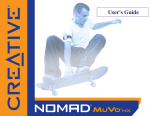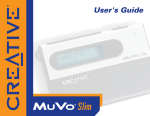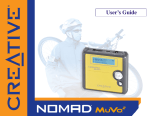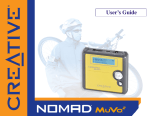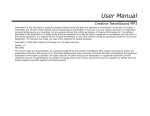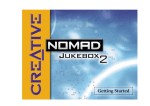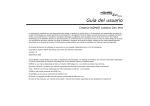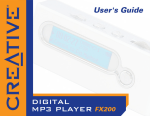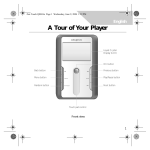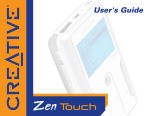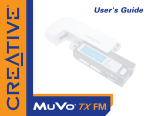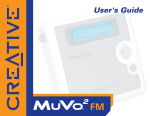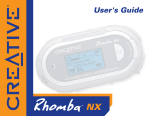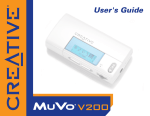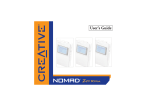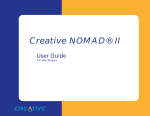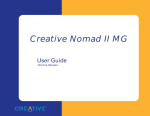Download Creative MUVO NX User`s guide
Transcript
User’s Guide Creative NOMAD MuVo NX Information in this document is subject to change without notice and does not represent a commitment on the part of Creative Technology Ltd. No part of this manual may be reproduced or transmitted in any form or by any means, electronic or mechanical, including photocopying and recording, for any purpose without the written permission of Creative Technology Ltd. The software described in this document is furnished under a license agreement and may be used or copied only in accordance with the terms of the license agreement. It is against the law to copy the software on any other medium except as specifically allowed in the license agreement. The licensee may make one copy of the software for backup purposes. The Software License Agreement is found in a separate folder on the installation CD. Copyright © 2003 Creative Technology Ltd. All rights reserved. Version 1.1 October 2003 MuVo and the Creative logo are trademarks or registered trademarks of Creative Technology Ltd. in the United States and/or other countries. NOMAD is a registered trademark of Aonix and is used by Creative Technology Ltd. and/or its affiliates under license. Microsoft and Windows are registered trademarks of Microsoft Corporation. All rights reserved. Intel and Pentium are trademarks of Intel Corporation in the U.S. and other countries. CDDB is a trademark of CDDB, Inc. All other products are trademarks or registered trademarks of their respective owners. Contents Contents Safety and Handling Instructions Caring For Your Player ................................................................ vi Introduction Before You Begin Package Contents ..................................................................... viii Software Included ...................................................................... viii Creative Media Detector .................................... viii Creative MediaSource ......................................... ix Creative MediaSource Player .......................................... ix Creative MediaSource Organizer .................................... ix Adobe Acrobat Reader ......................................... x Minimum System Requirements ................................................. x Document Conventions ............................................................... xi Web Information ......................................................................... xii Online Registration ..................................................................... xii 1 A Tour of Your Player Your Player at a Glance ........................................................... Using the Scroller ..................................................................... Scroll Select ...................................................... Selecting menu options .................................... 1-1 1-3 1-3 1-3 2 Getting Started ii Inserting the Battery ................................................................. Power Source and Level Indicators .................. Installing Drivers and Software ................................................. Connecting the USB Flash Drive to your Computer ................. 2-1 2-2 2-3 2-4 3 Transferring Tracks or Files Downloading from the internet ................................................. Creative MediaSource .............................................................. Transferring Tracks or Files .............................. Editing audio track information ......................... Ripping Audio CD Tracks ................................. 3-2 3-3 3-3 3-4 3-5 4 Using Your Player Turning On/Off your Player ...................................................... 4-1 Music Playback ........................................................................ 4-2 Playing music tracks ..................................................... 4-3 Play Modes ............................................................................... 4-4 Repeating music ........................................................... 4-5 Shuffling music ............................................................. 4-7 Playing a track once ..................................................... 4-8 Normal mode ................................................................ 4-9 Voice Recording ..................................................................... 4-10 Making a voice recording ............................................ 4-10 EQ Settings ............................................................................ 4-11 Enhancing Your Music ................................................ 4-11 Skipping Folders ..................................................................... 4-13 Deleting Tracks ...................................................................... 4-13 User Preferences ................................................................... 4-14 Locking and unlocking your Player ......................................... 4-17 iii Formatting Your Player .......................................................... 4-18 Appendixes A Technical Specifications Size ............................................................................... Weight .......................................................................... Capacity ........................................................................ Battery type .................................................................. Battery Life (playback time) .......................................... Interface ........................................................................ Playback Formats ......................................................... Voice Recording Formats ............................................. Signal to Noise Ratio .................................................... Channel Separation ...................................................... Frequency Response ................................................... Harmonic Distortion ...................................................... Operating System/Firmware ......................................... Headphone Out ............................................................ LCD Display .................................................................. Data Connector ............................................................ Firmware Support ......................................................... A-1 A-1 A-1 A-1 A-1 A-1 A-1 A-1 A-2 A-2 A-2 A-2 A-2 A-2 A-2 A-2 A-2 B Onscreen Diagram and Icon Guide Information Diagrams ............................................................... Playback Icons ......................................................................... Play Mode Icons ....................................................................... Error Diagrams ......................................................................... B-1 B-2 B-3 B-4 iv C FAQs and Troubleshooting AutoPlay ................................................................................... General ..................................................................................... Usage ....................................................................................... Digital Rights Management ...................................................... C-1 C-2 C-3 C-5 v Safety and Handling Instructions Caring For Your Player While your player is quite robust, observing these handling procedures will prolong its life. Do not store or use in areas exceeding 45ºC or 113ºF. Do not subject to excessive force or impact. Do not expose to heat or incinerate. Keep away from excessive moisture. Keep away from strong magnetic fields. Do not dismantle. vi Introduction Congratulations on making an excellent decision in purchasing the Creative NOMAD® MuVo® NX! Your new multi-format portable player allows you to store songs in the player’s music library and also comes equipped with an USB 1.1™ connector, so you can transfer audio tracks and data quickly and easily. Your player also supports Advanced EQ features for audio enhancement. Your portable digital audio player supports multiple audio file formats, including MP3 and WMA*. * For more information on DRM-protected WMA files, see "Digital Rights Management" on page C-5. vii Before You Begin Package Contents ❍ ❍ ❍ ❍ ❍ The package contents listed here may differ from country to country. ❍ ❍ NOMAD MuVo NX Player (consists of one USB Flash Drive and one battery module) Additional battery module Armband Installation CD incorporating PDF User’s Guide Quick Start Guide leaflet Stereo headphones One AAA size battery Software Included ❍ Creative Media Detector Media Detector makes it easy for you to access multimedia content from various internal or external media. There is no need to hunt through a maze of different software to play different types of files. ❍ ❍ Creative Media Detector Creative MediaSource Adobe Acrobat Reader Media Detector automatically recognizes the insertion or connection of CDs, VCDs, and external devices like Creative NOMAD MP3 players. Upon recognition, the content in the media will automatically start playing. viii Creative MediaSource Creative MediaSource is your ultimate all-in-one digital entertainment software, designed for playing, creating, organizing and transferring digital music. It includes several applications like the Player and Organizer. For more information and usage details on Creative MediaSource, refer to its online Help. Creative MediaSource Player Unlike other media players, Creative MediaSource Player provides exclusive features (such as SmartFit), specially designed to manage and configure your NOMAD MuVo NX more efficiently. With Creative MediaSource Player, you can play back a wide variety of digital audio and video formats such as MP3, WMA, WAV, Audio CD, Midi, VCD, AVI and MPEG-1 on the computer. You can also use the integrated recorder in Creative MediaSource to record audio. Creative MediaSource Organizer The Organizer can be considered an extended view of the Player, as it provides additional features to help you manage a huge music library more easily. With it, you can: ❍ rip Audio CDs and create high quality digital audio files (up to 320 kbps for MP3 and 160 kbps for WMA) ❍ configure the settings for the NOMAD MuVo NX while it is plugged-in to Creative MediaSource ❍ "squeeze" more audio tracks into your player with SmartFit, which employs intelligent track management and WMA compression ❍ view the contents of your computer and your NOMAD MuVo NX using the dual-window transfer panel, convenient for file transfer ❍ locate songs in a few seconds, just by typing some keywords into the sophisticated music search engine ix Adobe Acrobat Reader Adobe Acrobat Reader is a software that lets you view and print Adobe Portable Document Format (PDF) files on all major computer platforms. Minimum System Requirements ❍ ❍ ❍ ❍ ❍ The software applications on the installation CD may have higher requirements for basic functionality. Refer to each application’s documentation for details. ❍ ❍ ❍ Microsoft® Windows® 98 Second Edition (SE), Windows 2000, Windows Millennium Edition (Me) or Windows XP Intel® Pentium® II 350 MHz, AMD® K6-2® 450 MHz or better processor (Pentium III 450 MHz or higher recommended for MP3 encoding) CD-ROM drive with digital audio extraction support USB 1.1 port 64 MB RAM (128 MB recommended) 30 MB free hard disk space (more needed for storing audio) Installed mouse SVGA graphics adapter (256 colors, 800 x 600 resolution or better) x Document Conventions We use icons to highlight useful or urgent information for you: Tip. This tells you about shortcuts or hints relating to a feature. Note. This highlights additional or important information about a feature. Caution! This highlights proper usage of your player. Use this information to avoid situations involving risk. Warning! This warns you of possible hazards to yourself or your player, which may result in injury or damage. xi Web Information The driver updates only work with NOMAD MuVo NX players. Do not install these updates if you own a NOMAD MuVo player. Online Registration Visit www.NOMADworld.com regularly for information on: ❍ firmware updates ❍ NOMAD accessories ❍ tips and tricks ❍ FAQs ❍ troubleshooting ❍ documentation updates ❍ software updates or purchases ❍ technologies used in your player ❍ an online glossary Enjoy a host of benefits by registering your product during installation, or at www.creative.com/register. Benefits include: ❍ Service and Product support from Creative ❍ Exclusive updates on promotions and events xii 1 A Tour of Your Player A Tour of Your Player Your Player at a Glance Headphones connector Play/Pause button Scroller Microphone Volume Increase button Volume Decrease button LCD screen Front View Side View A Tour of Your Player 1-1 Button PLAY/PAUSE What It Does ❍ ❍ ❍ turns the player on and off activates LCD backlight starts, pauses or continues playback ❍ increases the volume ❍ decreases the volume Usage Tips press and hold until player turns on or off ❍ when your player is locked, press to turn LCD backlight on ❍ VOLUME INCREASE ❍ press and hold to increase the volume quickly ❍ press and hold to decrease the volume quickly VOLUME DECREASE during playback, turn the Scroller to go to the previous or next track. ❍ during playback, turn and hold the Scroller to fast-forward or rewind the track ❍ turn the Scroller to scroll through menu options and press the Scroller to select them. This action is also referred to as "Scroll Select" ❍ SCROLLER ❍ ❍ ❍ ❍ skips to the previous/next track fast-forwards/rewinds a track scrolls through menu options selects menu options A Tour of Your Player 1-2 Using the Scroller Scroll Select To "Scroll Select", use the Scroller to scroll to the option you want, and select the option by pressing the Scroller. The Scroller is one of the most important features of your NOMAD MuVo NX. In this document, we will use a new term, “Scroll Select”, to indicate that you should use the Scroller to scroll through options and then select the option by pressing the Scroller. The Scroller (side view) Use the Scroller to scroll through options Press the Scroller to select an option Depending on the screen you are in, you can have different menu options. You can also choose options from a list or a confirmation box. Selecting menu options You can use the Scroller to make selections in menus. For example, if you are looking at the Menu screen: From the Menu screen to the Play Mode Options screen 1. Use the Scroller to scroll through the menu options. 2. Press the Scroller to select the menu item. A Tour of Your Player 1-3 2 Getting Started Getting Started Inserting the Battery a b c Getting Started 2-1 Power Source and Level Indicators The amount of playback time available depends on various factors (for example, type of headphones used). For more information, see "Usage" on page C-3. After inserting the battery, your player displays one of the following icons, depending on the battery’s status. Icon What the icon means Notes ❍ your player’s battery is full ❍ your player’s battery is 60% full ❍ your player’s battery is 30% full ❍ your player’s battery is nearly empty ❍ this battery state icon shows that the battery is full ❍ change the battery at the earliest opportunity Getting Started 2-2 Installing Drivers and Software Windows 98 SE users must install the drivers to transfer tracks or files to the player. Your NOMAD MuVo NX comes with drivers for all operating systems, together with software that helps you create audio tracks, manage your music library and use your player. 1. Make sure that your player is not connected to your computer. 2. Insert the Installation CD into your CD-ROM drive. The disc supports Windows AutoPlay mode and starts running automatically. If not, you need to enable your CD-ROM drive's autoinsert notification feature. For more details see "AutoPlay" on page C-1. 3. Click the Install software for NOMAD MuVo NX option to select it. 4. Click the OK button. 5. Follow the onscreen instructions to complete the installation. 6. If prompted, restart your computer. To install the software, Windows 2000/XP users must log in as the computer administrator. For more information, refer to your operating system’s online Help. Getting Started 2-3 Connecting the USB Flash Drive to your Computer You are now ready to connect your player to your computer. Your NOMAD MuVo NX comes with a USB 1.1 port for data transfers to and from your computer. Be sure that you have installed Creative MediaSource before connecting your player. To transfer audio or data files to your player, refer to "Transferring Tracks or Files" on page 3-3. a USB Flash Drive USB port Battery module b USB port Getting Started 2-4 3 Transferring Tracks or Files Transferring Tracks or Files Creative MediaSource is included on your installation CD (see "Installing Drivers and Software" on page 2-3). To listen to transferred audio tracks, your player must be in Music mode. For more information, refer to "Using Your Player" on page 4-1. Creative MediaSource is the best way to organize and transfer audio to and from your player. This chapter includes basic instructions on using MediaSource to rip audio CDs, transfer tracks by manual selection, edit track information as well as to create and edit playlists. Alternatively, you can use Windows Explorer to transfer tracks/files. If you wish to download additional music tracks to your player, you can either download music tracks from Internet music sites (see "Downloading from the internet" on page 3-2) or have them "ripped" from audio CDs to your computer. Before disconnecting your player from your computer, make sure that you stop your player properly first (see "Usage" on page C3" for more details). Music files must, however, be encoded into the supported formats (MP3 or WMA file formats), then transferred to your player with Creative MediaSource Organizer. Data files can also be transferred and stored in your player. For example, if you want to transfer a large presentation or graphic file from one computer to another. Transferring Tracks or Files 3-1 Downloading from the internet To get MP3 files from the Internet, use a search engine to locate sites with MP3 content. You can also try out these sites (web sites listed here are correct at the time of this document’s release): ❍ NOMADWorld ❍ http://www.NOMADworld.com ❍ It is illegal to encode MP3 files for trade or sale unless you have the express or explicit permission of the copyright holder(s). SoundClick.com http://www.amp3.com ❍ http://www.soundclick.com ❍ Epitonic.com http://www.epitonic.com AMP3.com ArtistOne.com http://www.artistone.com ❍ Soundbuzz.com http://www.soundbuzz.com Follow the instructions on the site and download the music files to your computer. Transferring Tracks or Files 3-2 Creative MediaSource Only basic instructions on how to use MediaSource with your player are provided in this chapter— extensive instructions are found in the MediaSource Help file. Transferring Tracks or Files With Creative MediaSource, you can transfer files and audio tracks to and from your player. Using Creative MediaSource You must restart your computer before trying out any of the installed applications. 1. If you are not already in Creative MediaSource Organizer, click the Player/Organizer View button. 2. Click the Show/Hide Right Panel button. 3. In the Sources window, select the source device. If you are transferring files from PC Music Library to a portable hard disk, select PC Music Library as your source. 4. In the Content window, select the tracks to transfer. CTRL-click to select multiple tracks. 5. In the Right Panel window, click the Source bar and select the destination. 6. Click the Destination Transfer button to transfer the selected tracks. The Now Transferring dialog box appears, showing the current transfer status. Using Windows Explorer 1. On your desktop, right-click the My Computer icon, and then click Explore. 2. Drag and drop tracks/files into your player. Transferring Tracks or Files 3-3 Editing audio track information You may need to edit track information when the information is incomplete or wrong. To edit information about a track 1. If you are not already in Creative MediaSource Organizer, click the Player/Organizer View button. 2. In the Content window, locate the track you want to edit, and right-click it. 3. Select the Properties option. A dialog box appears. 4. Select the Tag Information tab. 5. Click on any of the track properties under the Property column. The entire row of information is highlighted. 6. Click on information in the Value field to edit the information. 7. Repeat steps 5 and 6 to change other track properties. 8. Click the OK button when all changes have been made. The new track information will be stored. To edit information about multiple tracks 1. If you are not already in Creative MediaSource Organizer, click the Player/Organizer View button. 2. In the Content window, locate the tracks you want to edit, hold down the CTRL key and select them. 3. Right-click to edit the Album, Artist or Genre. 4. Type in the new Album, Artist or Genre. 5. Click the OK button. Transferring Tracks or Files 3-4 Ripping Audio CD Tracks Rather than manually entering track information, retrieve such audio CD information from CDDB before ripping tracks. Change the default ripping format and bitrate for higher or lower quality audio. See MediaSource’s Help file for details The first phase in making an MP3 file is extracting audio data from an audio CD. To extract audio data, you will need a CD-ROM drive that can extract digital audio data, and a program known as a Ripper. With Creative MediaSource Organizer, you can rip tracks from most audio CDs. This program uses the CD-ROM drive to read the audio tracks from the audio CD and stores it on your hard disk. The time needed for a successful audio extraction depends on: ❍ CD-ROM drive speed ❍ defects, like scratches on the audio CD ❍ error-checking features on the CD-ROM drive Encoding is the second phase of making an MP3 file. Encoders are used to convert the stored audio tracks, usually WAV files, into MP3 files. MP3 encoding is considered lossy compression, which means that some data is lost during compression. However, using the standard sampling rate and bitrates will ensure that your MP3 files retain much of their audio quality. The standard bitrate of most MP3 files is 128 Kbps, although some are set higher, at 160 or 192 Kbps. Higher bitrates will result in larger MP3 file sizes, with better audio quality. Use Creative MediaSource Organizer to extract audio tracks and encode MP3s. You can rip an audio CD’s tracks to your player, hard disk or PC Music Library. You can choose to rip an entire CD, or selected tracks from the audio CD. Transferring Tracks or Files 3-5 To rip a CD 1. Insert an audio CD into your CD-ROM drive. 2. If you are not already in Creative MediaSource Organizer, click the Player/Organizer View button. 3. In the Sources window, select [E:] Audio CD (where E: represents your CD-ROM drive). 4. In the Task bar, click the Rip Now button. To rip tracks from an audio CD 1. Insert an audio CD into your CD-ROM drive. 2. If you are not already in Creative MediaSource Organizer, click the Player/Organizer View button. 3. In the Sources window, select [E:] Audio CD (where E: represents your CD-ROM drive). 4. In the Content window, select the tracks to rip. Ctrl-click or Shift-click to select multiple tracks. 5. Drag the selected tracks to PC Music Library in the Source window. The Transfer Queue dialog box appears, showing the current ripping status. Transferring Tracks or Files 3-6 4 Using Your Player Using Your Player Your player can function in Music or Voice mode. In Music mode, only .MP3 or .WMA files are played back and in Voice mode, only recorded voice files are played back. To switch between modes, see "Music Playback" on page 4-2. Your player also has Play Modes that allow you to change how your tracks are played back. For more information, see "Play Modes" on page 4-4. Turning On/Off your Player Remember to unplug the USB Flash Drive from your computer and insert it into the battery module before turning on the player. To turn on your player Press and hold the Play/Pause button If your player contains no audio tracks, the message "No Music" or "No Voice" will appear onscreen, depending on whether you are in Music or Voice mode. until your player turns on. The CREATIVE logo appears onscreen, followed by the MuVo NX logo. Music tracks stored in your player are automatically played back. To turn off your player Press and hold the Play/Pause button after the Power off message disappears. for a few seconds until Audio track filenames are sorted in alphanumeric order. Using Your Player 4-1 Music Playback To add audio tracks to your player, see "Transferring Tracks or Files" on page 3-3. If you are in Voice mode and the Voice Mode icon do the following to return to Music mode. appears onscreen, To enable Music mode 1. Press the Scroller. The Main Menu (Figure 4-1) appears. Figure 4-1 2. Scroll Select the Music icon (Figure 4-2). Figure 4-2 If you are in Music mode and the Music Mode icon the following to return to Voice mode. appears onscreen, do To enable Voice mode 1. Press the Scroller. The Main Menu (Figure 4-3) appears. Figure 4-3 2. Scroll Select the Voice icon (Figure 4-4). Figure 4-4 Using Your Player 4-2 Playing music tracks Follow these steps to play music tracks. 1. Press the Play/Pause button for a few seconds. The Creative MuVo NX logo appears onscreen, and music tracks stored in your player are automatically played back. Play Mode Icon Elapsed time Battery Level Indicator Play Status Icon EQ Setting Icon Music Mode Icon Track Title To pause a track Press the Play/Pause button . To stop a track Press the Play/Pause button Scroller forward. The Stop icon to pause the track, and then push the appears onscreen. Using Your Player 4-3 Play Modes Your player has Play Modes that allow you to change how your tracks are played back. The following Play Modes are available: Only one Play Mode can be enabled at a time. ❍ ❍ ❍ ❍ ❍ ❍ ❍ ❍ ❍ A-B Repeat Track Repeat All Repeat Folder Track Once Shuffle Repeat Shuffle Once Shuffle Folder Normal Play Modes are disabled by setting the “Normal” mode as described in "Normal mode" on page 4-9. Using Your Player 4-4 Repeating music You can choose to repeat a track, folder, all tracks or a portion of a track. 1. Press the Scroller. The Main Menu (Figure 4-5) appears. Figure 4-5 2. Scroll Select the Play Mode icon. A list appears (Figure 4-6). 3. Depending on which mode you want, follow the corresponding step: Figure 4-6 To repeat a track in the Playing List Scroll Select the Repeat Track icon. The Repeat Track icon appears onscreen and the track is repeated continuously until you stop it or skip to another track. To repeat a folder Scroll Select the Repeat Folder icon. Repeat Folder Mode is only available in Music mode. The Repeat Folder icon appears onscreen and tracks in the current folder is repeated continuously until you stop it or skip to another folder. Using Your Player 4-5 To repeat all tracks Scroll Select the Repeat All icon. The Repeat All icon appears onscreen and all tracks are repeated continuously until you stop playback. To repeat a portion of a track A portion of a track can only be repeated once; marking a new portion will automatically remove any markers in the track. 1. Scroll Select the A-B icon. The icon appears, prompting you to select a start point for the portion of music to repeat. 2. Press the Scroller to mark the begining of the portion you wish to repeat. The icon appears, prompting you to select an end point for the repeat function. 3. Press the Scroller again, to mark the end point of the portion of music to repeat. The marked portion of music is played back repeatedly. 4. To resume normal playback, enable “Normal” mode as described in "Normal mode" on page 4-9. Using Your Player 4-6 Shuffling music The Shuffle Play Mode can be used to shuffle all tracks (or tracks in a folder) once, or to repeatedly shuffle all tracks. 1. Press the Scroller. The Main Menu (Figure 4-7) appears. Figure 4-7 2. Scroll Select the Play Mode icon. A list appears (Figure 4-8). Figure 4-8 Depending on which mode you want, follow the corresponding step: To shuffle all tracks once Scroll Select the Shuffle Once icon. The Shuffle Once icon appears onscreen and a track is selected at random and played back. Playback stops playing once all the tracks in your player are played back once. To shuffle a folder once Scroll Select the Shuffle Folder icon. The Shuffle Folder icon appears onscreen and all tracks in the folder are selected at random and played back. Playback stops playing once all the tracks in the folder are played back once. Using Your Player 4-7 To Shuffle Repeat all tracks continuously Scroll Select the Shuffle Repeat icon. The Shuffle Repeat icon appears onscreen and tracks are selected at random and played back continuously until you stop playback. Playing a track once When the Track Once Play Mode is enabled, playback stops once the current track ends. 1. Press the Scroller. The Main Menu (Figure 4-9) appears. Figure 4-9 2. Scroll Select the Play Mode icon. A list appears. 3. Scroll Select the Track Once icon (Figure 4-10). The Track Once icon appears onscreen. Playback stops once the track ends. Figure 4-10 Using Your Player 4-8 Normal mode Once the "Normal" mode is enabled, each track is played back in a sorted order, from the first track to the last. 1. Press the Scroller. The Main Menu (Figure 4-11) appears. Figure 4-11 2. Scroll Select the Play Mode icon. A list appears. 3. Scroll Select the Normal icon (Figure 4-12). All tracks play back normally. Figure 4-12 Using Your Player 4-9 Voice Recording A great NOMAD MuVo NX feature is its ability to record audio. Recorded audio is encoded directly into IMA ADPCM (at 8 kHz, 4-bit, Mono) file format. When recording, note that the available recording time is determined by: ❍ ❍ available space in your player battery power remaining in your player When recording, you will see the time available for recording. You will also see a bar showing you the elapsed recording time. Elapsed Recording Time Remaining Time Available For Recording Making a voice recording To make a voice recording 1. Press the Scroller. Scroll Select the Record icon (Figure 4-13). The recording bar appears onscreen. Figure 4-13 You cannot pause the voice recording. 2. Press the Play/Pause button recording. to start the Press the Play/Pause button again to end the recording. A name is automatically assigned to your recording and it is saved in your player.The naming convention typically used is: VOC [Current File Number]. Using Your Player 4-10 EQ Settings Enhancing Your Music Your player allows you to enhance your listening experience with EQ settings. EQ settings available in your player include: Normal Rock Pop ❍ Classical ❍ Jazz ❍ Custom EQ ❍ ❍ ❍ You can use EQ settings with the audio being played back. This simple process is described in the following instructions. 1. Press the Scroller. The Main Menu (Figure 4-14) appears. Figure 4-14 2. Scroll Select the EQ icon (Figure 4-15). Figure 4-15 Depending on which EQ setting you want, follow the corresponding step: To select Normal, Rock, Pop, Classical or Jazz Scroll Select the EQ setting you want. The selected EQ setting icon appears onscreen. Using Your Player 4-11 To define your own EQ settings 1. Scroll Select the Custom EQ icon. The Custom EQ screen (Figure 4-16) appears. 2. Five vertical control levers will appear in the display. Each lever represents successively higher Figure 4-16 frequencies that can be controlled. 62 Hz controls bass frequency, 250 Hz adjusts the low mid-range frequency, 1 kHz adjusts the mid-range frequency, 4 kHz adjusts the upper mid-range frequency and 16 kHz adjusts the treble frequency. 3. Scroll Select each vertical control level. Use the Scroller to move the control knob up or down to vary the amount of boost or reduction in the selected frequency range. 4. Scroll Select the check mark to exit the Custom EQ window. Using Your Player 4-12 Skipping Folders Your player can only recognize up to one sub folder level in the root directory. Deleting Tracks This action skips the playback to a selected folder. To skip to the next folder 1. 2. 3. 4. Press the Scroller. Scroll Select the Skip Folder icon (Figure 4-17). Scroll to the folder that you want to skip to. To resume normal playback, press the Scroller again. Figure 4-17 This action permanently deletes tracks from your NOMAD MuVo NX. To delete a track 1. In Music mode, select the track that you want to delete. 2. Press the Scroller. 3. Scroll Select the Delete icon (Figure 4-18). A list appears. Figure 4-18 4. Scroll Select the Delete icon (Figure 4-19). The track’s name appears onscreen and the track is permanently deleted from your player. Figure 4-19 Using Your Player 4-13 User Preferences These features are only available in Music Mode and Voice Mode. Your player offers many configuration options. You can ❍ ❍ ❍ ❍ ❍ ❍ change the LCD orientation specify contrast settings change the LCD screen’s backlight duration specify how long the player remains inactive before it automatically shuts down select the default language access the information screen 1. Press the Scroller. 2. Scroll Select the Settings icon (Figure 4-20). A list appears (Figure 4-21). Figure 4-20 Figure 4-21 Using Your Player 4-14 Depending on which configuration option you want, follow the corresponding step: To rotate the LCD screen 180 degrees Left-handed users may find this feature useful. Using your left hand Using your right hand Scroll Select the LCD Orientation icon . The LCD screen rotates 180 degrees (Figure 4-22). Figure 4-22 Using Your Player 4-15 To set the contrast level for your player’s screen 1. Scroll Select the Contrast icon. The Contrast screen (Figure 4-23) appears. 2. Use the Scroller to increase or decrease the LCD contrast. The lower the number, the lower the LCD contrast. Figure 4-23 To adjust the screen backlight duration 1. Scroll Select the Backlight icon. 2. Scroll Select the backlight duration or disable it. A lower number setting conserves battery power for longer playback time. To specify how long the player remains inactive before it automatically shuts down 1. Scroll Select the Idle Shutdown icon. 2. Scroll Select the duration you want the player to wait before automatically shutting down. To change the default language 1. Scroll Select the Language icon. 2. Scroll Select the language that you want. To view firmware version, total storage space, remaining available space and track count 1. Scroll Select the Information icon. Using Your Player 4-16 Locking and unlocking your Player Locking your NOMAD MuVo NX will disable all buttons on the player. This feature is useful when you do not want any buttons (for example, Pause) pressed accidentally. If you press a button while the player is locked, a popup window appears for you to unlock the player. This popup disappears if you don’t use the Scroller to make a selection after five seconds. To lock your player 1. Press the Scroller. 2. Scroll Select the Lock icon (Figure 4-24). The player is locked. To unlock your player Figure 4-24 1. Press any button. A popup appears (Figure 4-25). 2. Scroll Select the Unlock icon. The player is unlocked. Figure 4-25 Using Your Player 4-17 Formatting Your Player Windows 98 SE users must install the NOMAD MuVo NX drivers before formatting the player. For more information on driver installation, see "Installing Drivers and Software" on page 2-3". Windows 2000 and Windows XP users must select FAT only in the Format F:\ dialog box before formatting the player. If you need to format your player, backup the files in your player first. When you format your player, all songs and files will be deleted. By default, your player is already formatted. 1. Connect your player to your computer’s USB port using the supplied USB cable. 2. Launch Windows Explorer on your computer. Your player is recognized as a Removable Disk in Windows Explorer. 3. Right-click the Removable Disk icon and click the Format option. The Format F:\ dialog box appears (replace F:\ with the drive letter of your player). 4. Follow the onscreen instructions to format your player. Figure 4-26 5. After the formatting is complete, make sure you stop your player before disconnecting it from your computer. See "Usage" on page C-3 for instructions on stopping your player. For more information about using Windows Explorer, refer to its online Help. Using Your Player 4-18 A Technical Specifications Technical Specifications Size ❑ 36.7 mm (L) x 74.0 mm (H) x 16.0 mm (W) Weight ❑ 31.5 g (without the battery) or 43 g (with a AAA battery) Capacity ❑ 128 or 256 MB built-in memory Battery type ❑ One Alkaline AAA size battery Battery Life (playback time)* ❑ MP3 128 kbps, up to 11 hours of continuous playback from new AAA alkaline atteries. ❑ WMA 64 kbps, up to 9 hours of continuous playback from new AAA alkalinebatteries. Interface ❑ USB 1.1 Playback Formats ❑ MP3 (at 8, 11.025, 12, 16, 22.05, 24, 32 and 44.1 kHz) ❑ WMA (at 16, 22.05, 24, 32 and 44.1 kHz) Voice Recording Formats ❑ IMA ADPCM (at 8 kHz, 4-bit, Mono) * The • • • • following may reduce the playback time: skipping, fast forward or reverse during playback using passive speakers or high-power headphones long backlight timeout setting (more than 10 secs) playback of .WMA files with a high bitrate and/or heavy bass Battery life estimated for playback of tracks encoded at 128 kbps. Technical Specifications A-1 Signal to Noise Ratio ❑ >90 dB (Headphones) Channel Separation ❑ >63 dB (Headphones) Frequency Response ❑ 20 Hz~20000 Hz Harmonic Distortion ❑ <0.05% Operating System/ Firmware ❑ Upgradeable via Internet Headphone Out ❑ 1/8" stereo minijack, 5~7 mW LCD Display ❑ Large 96 x 32 pixel, blue EL backlit display Data Connector ❑ USB 1.1 Firmware Support** ❑ Upgradeable ** Firmware upgrades are available from www.NOMADworld.com Technical Specifications A-2 B Onscreen Diagram and Icon Guide Onscreen Diagram and Icon Guide Information Diagrams Diagram Action/Meaning ❍ your player is connected to your computer. To use your player, disconnect it from your computer. ❍ files are being transferred to your player. Onscreen Diagram and Icon Guide B-1 Playback Icons Icon The following icons appear onscreen when the associated playback action is used. Action/Meaning ❍ Play ❍ Pause ❍ Stop ❍ Forward ❍ Reverse ❍ Skip forward ❍ Skip back Onscreen Diagram and Icon Guide B-2 Play Mode Icons Icon Action/Meaning ❍ Repeat Track ❍ Repeat Folder ❍ Repeat All ❍ Shuffle Once ❍ Shuffle Repeat ❍ Shuffle Folder ❍ Track Once ❍ Repeats a selected section of a track Onscreen Diagram and Icon Guide B-3 Error Diagrams If an error occurs, you may see the following diagram, indicating the general nature of the problem. Diagram Likely Causes Suggested Action ❍ ❍ physical defects numerous highimpact shocks ❍ unexpected power loss while saving settings ❍ player is unable to perform the selected task (for example, deleting a file) ❍ call Technical Support download a newer firmware version ❍ reload firmware ❍ call Technical Support ❍ clear your player’s memory ❍ call Technical Support ❍ check that the file system you have selected during formatting is FAT only ❍ use ScanDisk to check your player ❍ unsupported file system ❍ corrupted file system ❍ Onscreen Diagram and Icon Guide B-4 Diagram Likely Causes Suggested Action ❍ ❍ unsupported file format check that the file you are trying to play back is a .WMA, .MP3 or recorded voice file ❍ corrupted audio file check that your recorded voice file is not corrupted ❍ clear your player’s memory ❍ the player’s low remaining storage space will be depleted; recording cannot proceed ❍ delete some files battery is depleted, player cannot start up ❍ insert a new battery ❍ ❍ Onscreen Diagram and Icon Guide B-5 C Frequently Asked Questions and Troubleshooting FAQs and Troubleshooting AutoPlay What do I do when the installation does not start automatically after the Installation CD is inserted? The AutoPlay feature in your Windows system may not be enabled. To start the installation program through the My Computer shortcut menu 1. On your Windows desktop, double-click the My Computer icon. 2. Right-click the CD-ROM drive icon, and then click AutoPlay. 3. Follow the onscreen instructions. To enable AutoPlay through Auto Insert Notification 4. Click Start -> Settings -> Control Panel. 5. Double-click the System icon. The System Properties dialog box appears. 6. Click the Device Manager tab and select your CD-ROM drive. 7. Click the Properties button. 8. Click the Settings tab, and then select Auto Insert Notification. 9. Click the OK button. To start the installation program through Windows Explorer 1. in Windows Explorer, search and locate the d:\ctrun folder (replace d:\ with the drive letter of your CD-ROM drive). 2. Double-click the ctrun.exe file. FAQs and Troubleshooting C-1 General Where can I get official information on all NOMAD products? Visit NOMADworld for updates and downloads relating to all NOMAD products, Creative’s MP3 players and accessories. Visit www.NOMADworld.com. Windows XP tells me that the software for the player is not certified. What do I do? At the time of this product's release, Microsoft strongly encouraged companies to submit their hardware solutions for certification. If a hardware device driver is not submitted, or does not qualify, for Microsoft certification, a warning message similar to the one below appears. You may see this message when installing this driver or update. If you do, you may choose to click the Continue Anyway button. Creative has tested this driver or update on Windows XP, and it does not impair or destabilize your computer. FAQs and Troubleshooting C-2 Usage After playing a sequence of tracks, the player skips a track. The player will only play valid formats (.MP3, .WMA or .WAV recordings). Other types of files will be skipped. Files/tracks are corrupted when transferred to the player. Transfer may have been interrupted. Before disconnecting your player from your computer, make sure that you stop your player properly first. To stop your player in Windows 98 SE In Windows Explorer, right-click the Removable Disk icon, click the Eject option, and disconnect your player when you are prompted to do so. To stop your player in Windows 2000, Windows Me or Window XP Click the Safely Remove Hardware icon on the Taskbar, click Safely remove USB Mass Storage Device, and disconnect your player when you are prompted to do so. FAQs and Troubleshooting C-3 The player turns off immediately after it is turned on. Do one or more of the following: format your player. For more information, refer to "Formatting Your Player" on page 4-18. ❍ check that the batteries used are not depleted. ❍ File transfers to the player are very slow (less than 100 kb/sec). Try formatting your player. For more information, refer to "Formatting Your Player" on page 4-18. Can I use the NOMAD MuVo NX for portable data storage? Yes, you can. I have to change the battery quite often. Is there anything I can do to make it last longer? Some operations consume more battery power: ❍ ❍ ❍ ❍ ❍ ❍ a long backlight timeout setting. A shorter timeout conserves battery power. a high contrast setting. Position the player so that you can read the display without using a high contrast setting. too much use of fast forward/reverse. turning the player on/off too many times. use of passive speakers or high-powered headphones. playback of .WMA files FAQs and Troubleshooting C-4 Digital Rights Management Can I play DRM-protected WMA files on my Nomad MuVo NX? WMA files protected by Digital Rights Management (DRM) are unsupported by this model. FAQs and Troubleshooting C-5


































































